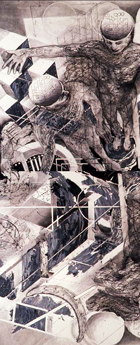
for everything you never thought to ask

| Home |
| God |
|
Names of God Concepts of God Theories of God Theism Atheism |
| Religion |
| Prayer |
| Spirit |
| Saints |
| Angels |
| Reality |

theories of God:Monotheism, Polytheism, Pantheism, Animism and AtheismThe terms: monotheism, polytheism, and pantheism began to be used by Western scholars of the 18th and 19th centuries to differentiate, categorize and define the different religions of the world. Monotheism refers to the worship of only one Supreme Being; polytheism refers to the worship of multiple deities. Pantheism was defined as the belief that the natural world is divine or that divinity permeates the world. This can encompass both those religions which worship the spirits of natural forces and objects of the natural world as divine and those which hold that the transcendent God inhabits and pervades all existent things. The former was termed animism; the latter is monism. Atheism refers to the rejection of any idea of God at all. There is inherent in these characterizations, the implicit presumption of a hierarchy, and that hierarchy was explicitly attached to these terms. Pantheism is understood as the most primitive, monotheism as the most developed. These thinkers and writers surmised that human ideas would have developed from primitive to sophisticated. Using these criteria they presumed that Euro-American societies with monotheistic religions, Renaissance intellectual insights, and complex social structures represented the culmination of human social evolution. The corollary to that was that tribal societies and their religions represented "primitive" forms of human ideas and societies. Early theories held that humans first began to anthropomorphize forces of nature and to seek to propitiate them through religious rituals. It was thought that humans then developed further religious ideas, creating mythologies of numerous divine beings who could be worshiped and petitioned for assistance and blessings in this life and the next. Finally, as humans developed greater understanding and control of the natural world, monotheistic religions emerged. Many of the scholars also held that this progression should lead intelligent people to the realization that there was, in fact no God, only natural forces which could be studied, understood, and controlled for our benefit. This form of intellectual atheism, which rejects both God and religion as vestiges of primitive thinking processes, has become prevalent in modern Euro-American societies. Even among many religiously minded, the categories of monotheism, polytheism and pantheism have become accepted as defining the different types of religion in the world. In the latter part of the twentieth century, many cultural anthropologists and scholars of world religions began to question whether these categories accurately reflected the complexity and depth of societies, cultures and religions around the world today. Tribal religions were found to be, in fact, quite sophisticated; many of the religions designated as polytheistic have turned out to have pronounced monotheistic core qualities; and western monotheisms, on closer inspection, have a lot in common with polytheistic views of God. |


"theories"
| monotheisms |
| polytheisms |
| pantheisms |
| atheisms |
| monisms |
| God is-is not |
| some links may not yet have taken birth - they will awaken - please wait for them |